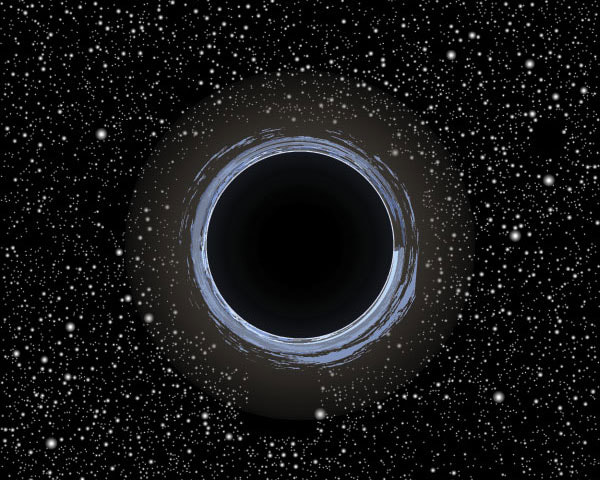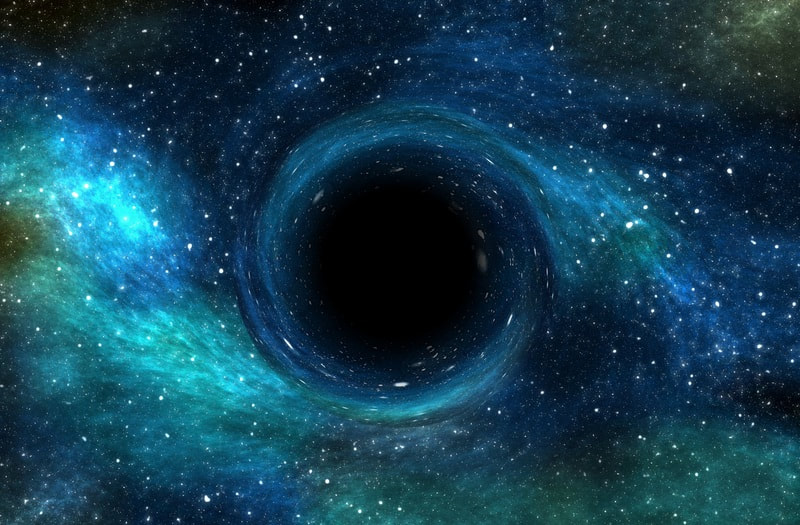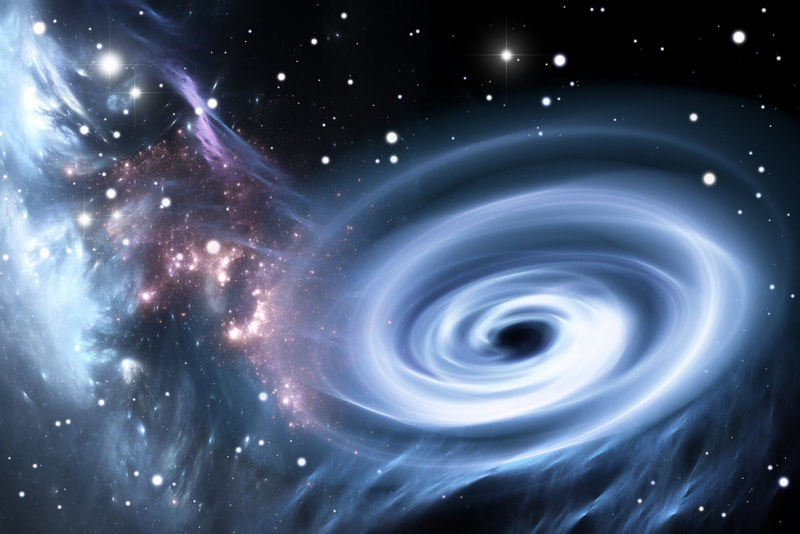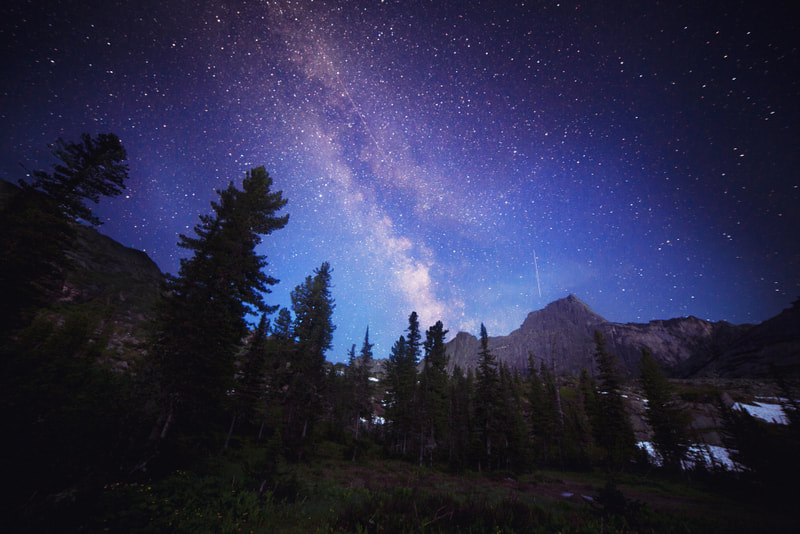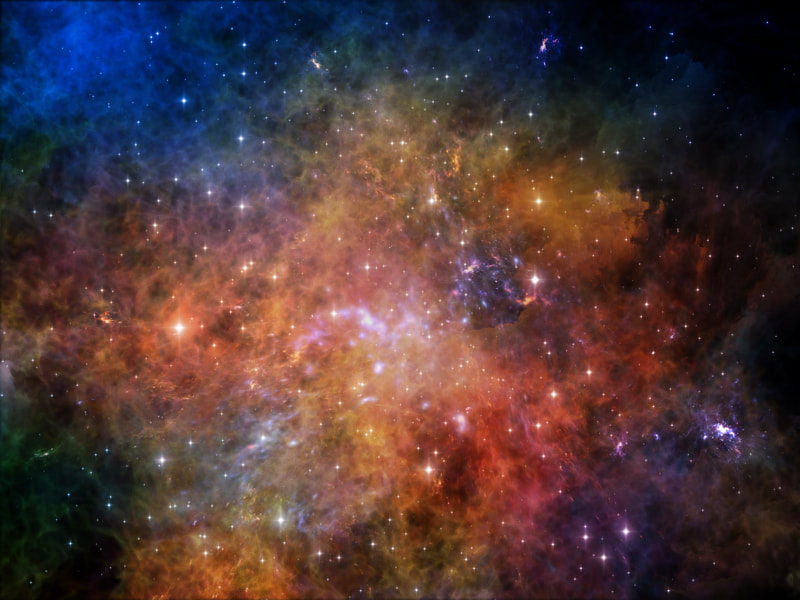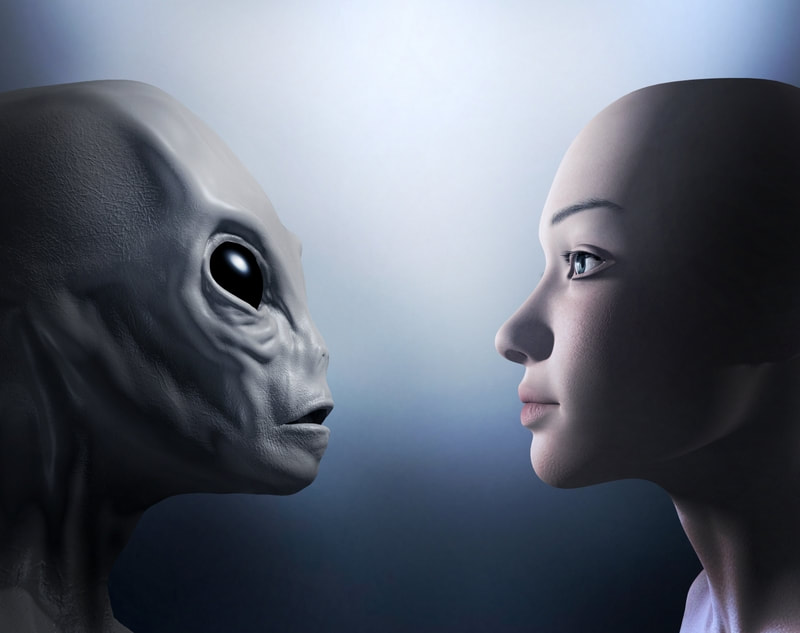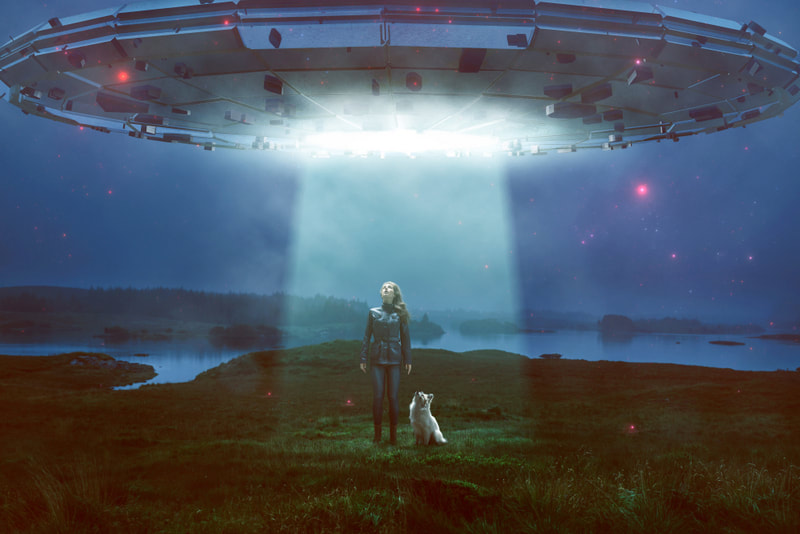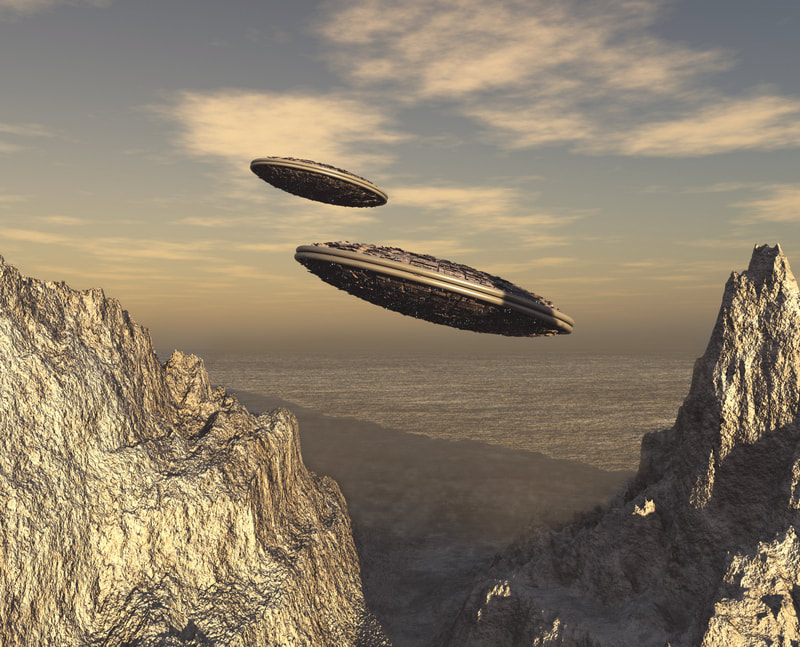Black holes
A black hole is found in space. It is an area where gravity is so strong that not even light can escape from inside it. In this section, we’ll go into more depth about what a black hole is and how black holes form and evolve.5.1.1 What is a black hole?
Black holes are invisible, so they cannot be recognized by any of their own distinguishing features. However, they are identified using space telescopes, which can identify strange star behavior. Stars close to black holes act differently to other stars, and this unusual activity can be picked up on space telescopes, leading to the discovery of black holes.
Black holes can be tiny, as small as one atom, but with the mass of a huge mountain, or they can be any size up to ‘supermassive’. Supermassive black holes have incredible masses, more than one million masses of our Sun, and it is thought that each large galaxy in the universe has a supermassive black hole, right at its center. There is indeed a supermassive black hole at the center of our galaxy, the Milky Way, and it is called Sagittarius A. It is so large it could fit a few million Earths inside it.
A black hole is found in space. It is an area where gravity is so strong that not even light can escape from inside it. In this section, we’ll go into more depth about what a black hole is and how black holes form and evolve.5.1.1 What is a black hole?
Black holes are invisible, so they cannot be recognized by any of their own distinguishing features. However, they are identified using space telescopes, which can identify strange star behavior. Stars close to black holes act differently to other stars, and this unusual activity can be picked up on space telescopes, leading to the discovery of black holes.
Black holes can be tiny, as small as one atom, but with the mass of a huge mountain, or they can be any size up to ‘supermassive’. Supermassive black holes have incredible masses, more than one million masses of our Sun, and it is thought that each large galaxy in the universe has a supermassive black hole, right at its center. There is indeed a supermassive black hole at the center of our galaxy, the Milky Way, and it is called Sagittarius A. It is so large it could fit a few million Earths inside it.
How does a black hole form and evolve?
Scientists are not at all sure how the supermassive black holes at the center of every galaxy were formed, though they think they were formed at the same time as their galaxy. On the other hand, astronomers have detailed knowledge about how smaller black holes form. Some are formed when dense objects (e.g. neutron stars) collide with each other, but much more common are black holes formed from stars.
Black holes formed from stars, also known as stellar black holes, come about when a very large star collapses in on itself, sparking a supernova. This supernova is an explosion, which blasts part of the star away and into space.
Scientists are not at all sure how the supermassive black holes at the center of every galaxy were formed, though they think they were formed at the same time as their galaxy. On the other hand, astronomers have detailed knowledge about how smaller black holes form. Some are formed when dense objects (e.g. neutron stars) collide with each other, but much more common are black holes formed from stars.
Black holes formed from stars, also known as stellar black holes, come about when a very large star collapses in on itself, sparking a supernova. This supernova is an explosion, which blasts part of the star away and into space.
Stars are held together by two forces that oppose one another. These forces are 1. the outward pressure of the radiation they emit, and 2. the inward pressure of gravity. If gravity was not there, the star would simply disintegrate. If the outward pressure was not there, the star would collapse in on itself.
The star begins by fusing hydrogen into helium, followed by fusing carbon, then oxygen. Stars the size of our Sun will stop there, cooling down to become a white dwarf. But more massive stars are massive enough to continue fusion, and will move onto other elements such as silicon, aluminum, potassium, and more. Eventually they’ll come to iron. But when iron is fused, no energy can be produced. At this point, gravity overpowers the outward force, and the star collapses in on itself. This creates a black hole.
Although black holes do eventually dissolve, this is a process that can take billions of years.
The star begins by fusing hydrogen into helium, followed by fusing carbon, then oxygen. Stars the size of our Sun will stop there, cooling down to become a white dwarf. But more massive stars are massive enough to continue fusion, and will move onto other elements such as silicon, aluminum, potassium, and more. Eventually they’ll come to iron. But when iron is fused, no energy can be produced. At this point, gravity overpowers the outward force, and the star collapses in on itself. This creates a black hole.
Although black holes do eventually dissolve, this is a process that can take billions of years.
The Milky Way and other galaxiesThe Milky Way galaxy is the one which houses our Solar System, and therefore Earth. In this section you’ll learn more about galaxies in general, and more about our own galaxy.
5.2.1 Understanding more about galaxies
Until the 1920s, astronomers didn’t even know there were more galaxies than our own. Edwin Hubble became able to precisely measure distances in the universe, and this led to astronomers finding that the fuzzy patches they had previously classified as nebula were actually galaxies. Now it is known there are trillions of galaxies across the universe.
A galaxy is essentially stars, dust and gas held together by gravity, thought to have been caused by the Big Bang. There are three galaxy shape types – elliptical, spiral, and irregular.
Elliptical galaxies cannot form new stars, so contain the oldest stars. They are very bright galaxies. For example, if the Earth were in an elliptical galaxy instead of a spiral one, there would be day light all the time, and no night would exist.
Spiral galaxies, such as the Milky Way, have spiral arms in which the gas, dust and stars are mainly concentreated.
Irregular galaxies were thought to be elliptical or spiral galaxies that crashed into other galaxies and lost their shape.
5.2.1 Understanding more about galaxies
Until the 1920s, astronomers didn’t even know there were more galaxies than our own. Edwin Hubble became able to precisely measure distances in the universe, and this led to astronomers finding that the fuzzy patches they had previously classified as nebula were actually galaxies. Now it is known there are trillions of galaxies across the universe.
A galaxy is essentially stars, dust and gas held together by gravity, thought to have been caused by the Big Bang. There are three galaxy shape types – elliptical, spiral, and irregular.
Elliptical galaxies cannot form new stars, so contain the oldest stars. They are very bright galaxies. For example, if the Earth were in an elliptical galaxy instead of a spiral one, there would be day light all the time, and no night would exist.
Spiral galaxies, such as the Milky Way, have spiral arms in which the gas, dust and stars are mainly concentreated.
Irregular galaxies were thought to be elliptical or spiral galaxies that crashed into other galaxies and lost their shape.
The Milky Way
Facts about the Milky Way include:
Facts about the Milky Way include:
- We live around halfway out from the center of the Milky Way. Our Solar System is in one of the four arms of the Milky Way, rather than close to the center. This arm contains clusters, to one of which the Milky Way belongs.
- Our galaxy is contained in the Local Group, which contains at least 40 galaxies, including two large spiral galaxies, our own, and the galaxy known as Andromeda. The other galaxies are much smaller, and around 65% of these are spiral galaxies.
- The Milky Way is a spiral galaxy, shaped like a whirlpool. It makes one rotation in 230 million years, and is around 100 light years in diameter.
- As the Milky Way rotates, the Solar System travels through space. We travel at around 515,000 miles per hour!
- The Milky Way is not only rotating, it is also moving through our universe. Our galaxy is predicted to crash with the Andromeda Galaxy, our nearest neighbor, in around four billion years from now. At the moment, the Milky Way and Andromeda are hurtling toward each other at around 70 miles each second! This will create new stars, and will by no means be the end of either galaxy. There is evidence that Andromeda has collided with a different galaxy in the past.
- There are at least 100 billion stars in the Milky Way, and it also contains gases and dust. New stars are constantly forming. Over half the stars in our galaxy are older than our Sun, which was formed 4.5 billion years ago. The most common type of star in our galaxy is the red dwarf.
- There is ablack hole at the center of the Milky Way, but a little way out from that is the galactic bulge. This is crammed with stars, dust and gas. This is the reason why we cannot see the whole galaxy, because the dust and gas block our view of the other side of the galaxy.
- The dust and gas in the galactic bulge feeds the black hole at the center and make it bigger.
- The Milky Way is surrounded by a halo, hundreds of thousands of light years wide, of hot gas, globular clusters and old stars.
- A mysterious element of the Milky Way is its dark matter, thought to make up 90% of the galaxy. Scientists can’t directly detect this material, but can identify it based on how it affects celestial objects near it.
The Big Bang theory
The Big Bang theory is a theory to explain what could have happened at the beginning of our universe. This is not based on an assumption, because discoveries in physics and astronomy have pointed to the fact that our universe did actually have a beginning, some billions of years ago. At some point, nothing changed into something – our universe. But how did this happen? This takes us into the field of cosmogony, the study of the beginning of the universe.
The Big Bang theory puts forward that 13.7 billion years ago, our universe first came into existence as a singularity. A singularity is a zone at the core of a black hole, which is little understood by physics at present. In the core of the black hole, there is a strong gravitational pressure, so intense that finite matter is squashed into infinite density, it is thought. It is not known where this singularity that became our universe came from, or why it appeared.
Then, at some point, this hot, small, intense singularity began to expand and cool, creating our universe. Even up to the present day, it is still expanding and cooling.
The Big Bang theory is a theory to explain what could have happened at the beginning of our universe. This is not based on an assumption, because discoveries in physics and astronomy have pointed to the fact that our universe did actually have a beginning, some billions of years ago. At some point, nothing changed into something – our universe. But how did this happen? This takes us into the field of cosmogony, the study of the beginning of the universe.
The Big Bang theory puts forward that 13.7 billion years ago, our universe first came into existence as a singularity. A singularity is a zone at the core of a black hole, which is little understood by physics at present. In the core of the black hole, there is a strong gravitational pressure, so intense that finite matter is squashed into infinite density, it is thought. It is not known where this singularity that became our universe came from, or why it appeared.
Then, at some point, this hot, small, intense singularity began to expand and cool, creating our universe. Even up to the present day, it is still expanding and cooling.
Evidence for the Big Bang
There are four main pieces of evidence for the Big Bang theory, though some of these evidences also apply to other theories.
There are four main pieces of evidence for the Big Bang theory, though some of these evidences also apply to other theories.
- Physicists and astronomers are almost certain that the universe did have a beginning, based on research they have carried out.
- Hubble’s Law. Edwin Hubble discovered in 1929 that galaxies appear to be moving further away from us, at a greater speed the further away they are. This suggests that the universe was once compacted, and that the universe is expanding.
- In 1965, radio astronomers found some Cosmic Microwave Background radiation, which may be the remnant of the initial high heat of the universe. Amo Penzias and Robert Wilson found that this radiation permeates our universe, and in 1978 they won a Nobel Prize for their discovery.
- It is also thought that the high levels of helium and hydrogen found in our universe support the Big Bang theory, as these are ‘light elements’.
The existence of extraterrestrial life
The term extraterrestrial means ‘outside of Earth’, so when we use the phrase extraterrestrial life forms, we refer to forms of life that do not originate from the Earth.
Though there is no proof that life outside of Earth exists, most scientists expect that extraterrestrial life does in fact exist. Whether that takes the form of tiny organisms akin to bacteria, or beings with more advanced civilizations than us, there is a possibility it exists. It is hypothesized that microorganisms exist both in the Solar System and outside of it.
Various scientists put forward that the chemistry of life as we know it may have come into play when the Universe was 10 to 17 million years old, and they contend that life could have come about in many different places at this time. Alternatively, life could have been spread by meteoroids and other methods between livable planets.
Scientists argue that ‘habitable zones’ that orbit around stars like our Sun are the most likely places we will find extraterrestrial life. Using these criteria, researchers have put forward that, in the universe, there might be as many as 40 billion planets similar to Earth in composition, within the Milky Way alone. Only a small number have been discovered, though.
The term extraterrestrial means ‘outside of Earth’, so when we use the phrase extraterrestrial life forms, we refer to forms of life that do not originate from the Earth.
Though there is no proof that life outside of Earth exists, most scientists expect that extraterrestrial life does in fact exist. Whether that takes the form of tiny organisms akin to bacteria, or beings with more advanced civilizations than us, there is a possibility it exists. It is hypothesized that microorganisms exist both in the Solar System and outside of it.
Various scientists put forward that the chemistry of life as we know it may have come into play when the Universe was 10 to 17 million years old, and they contend that life could have come about in many different places at this time. Alternatively, life could have been spread by meteoroids and other methods between livable planets.
Scientists argue that ‘habitable zones’ that orbit around stars like our Sun are the most likely places we will find extraterrestrial life. Using these criteria, researchers have put forward that, in the universe, there might be as many as 40 billion planets similar to Earth in composition, within the Milky Way alone. Only a small number have been discovered, though.
The search for extraterrestrial life
Since the mid-1900s, humanity has been continuously searching for what we call extraterrestrial intelligence. This was partly sparked by the science fiction literary community, as well as the film industry, and particularly Hollywood. By including extraterrestrial life in fiction, they have sparked the interest of the wider public.
Various projects and areas of interest include:
Since the mid-1900s, humanity has been continuously searching for what we call extraterrestrial intelligence. This was partly sparked by the science fiction literary community, as well as the film industry, and particularly Hollywood. By including extraterrestrial life in fiction, they have sparked the interest of the wider public.
Various projects and areas of interest include:
- Applying the mediocrity principle – the concept that on Earth our progress is not exceptional, but normal, and that our planet is average, our Solar System is average and our galaxy is average – scientists have come to think that we might not hear from extraterrestrials for the next 1,500 years. It wasn’t until 1936, the broadcast of the Berlin Olympics, that we created a radio signal that was strong enough to lead Earth. It traveled 80 light years from the planet. Given that our Earth could be of average development, we could expect other civilizations to be at a similar level, and that it would take 1,500 years for successful communication to happen.
- In 2016, various space agencies are launching missions to Mars, some to hunt for signs of life.
- In 2013, the planet Kepler-62f was announced as the smallest planet in the habitable zone found so far. It is 40% larger than Earth, and is located in the Lyra constellation around 1200 light years away from us. Astronomers are still investigating.
- It is thought that one of Jupiter’s moons, Europa, supports life in the ocean underneath its icy surface.
- In 2015, a star named KIC 8462852 was found to have an oddity in the light it was emitting. Researchers have suggested this could be because of a Dyson sphere, an alien megastructure built around a star to capture energy. This energy could then be used to power an advanced civilization. Alternatively, it could be due to unusually high comet activity. Through crowdfunding, a team at Yale University hope to keep observing the star.
- A study found that, based on the amount of habitable planets in the universe, that the probability of an alien civilization developing on a habitable planet would have had to have been less than 1 in 10 billion trillion, for humanity to be the first advanced species in the universe. This seems very unlikely, leading scientists to conclude that other intelligent species that produced technology are extremely likely to have evolved before us.
- A star just 39 light years away is proving exciting for scientists. It is a cold, red star, 2,000 times dimmer than our Sun, and it has three planets orbiting around it. The University of California found these planets are only 10% larger than Earth, and could potentially house life.
- Earth’s pale blue color and its overall color spectrum, displays a subtle signature that can only be attributed to life, as far as we know for far. This could prove useful for searching for life on other planets, as a similar signature of planet colors in other star’s habitable zones could indicate life. This would help us focus on selecting planets to study further.
- In 2015, a star named KIC 8462852 was found to have an oddity in the light it was emitting. Researchers have suggested this could be because of a Dyson sphere, an alien megastructure built around a star to capture energy. This energy could then be used to power an advanced civilization. Alternatively, it could be due to unusually high comet activity. Through crowdfunding, a team at Yale University hope to keep observing the star.
- A study found that, based on the amount of habitable planets in the universe, that the probability of an alien civilization developing on a habitable planet would have had to have been less than 1 in 10 billion trillion, for humanity to be the first advanced species in the universe. This seems very unlikely, leading scientists to conclude that other intelligent species that produced technology are extremely likely to have evolved before us.
- A star just 39 light years away is proving exciting for scientists. It is a cold, red star, 2,000 times dimmer than our Sun, and it has three planets orbiting around it. The University of California found these planets are only 10% larger than Earth, and could potentially house life.
- Earth’s pale blue color and its overall color spectrum, displays a subtle signature that can only be attributed to life, as far as we know for far. This could prove useful for searching for life on other planets, as a similar signature of planet colors in other star’s habitable zones could indicate life. This would help us focus on selecting planets to study further.
1952, Washington D.C. – As a result of several reports of UFO sightings, and mysterious radar activity at three airports, the CIA Robertson panel was set up. The U.S. Air Force, however, suggested that temperature changes had given false radar signals.
1957, Levelland, Texas – A glowing egg-shaped object was the cause of car engines stalling in Levelland, Texas. Once the object had left, the engine started back up again. A police investigation concluded an electrical storm had caused the phenomenon, but not everyone was convinced.
1966, Westall – In Westall, Melbourne, Australia, a potential UFO was witnessed by over 200 teachers and students. An object was seen descending into a field, before taking off over houses. Some people think it was an experimental military aircraft, while others maintain it was extraterrestrial activity.
1967, Shag Harbour, Nova Scotia – A huge unidentified object crashed into this harbor in Nova Scotia. An investigation could not solve the case or identify the object.
1980, Rendlesham Forest Lights – In Rendlesham Forest, Suffolk, UK, there was a sighting of several unexplained lights, which appeared near RAF bases, by on-duty servicemen. It was though these lights could be from alien spacecraft, up to this day.
1957, Levelland, Texas – A glowing egg-shaped object was the cause of car engines stalling in Levelland, Texas. Once the object had left, the engine started back up again. A police investigation concluded an electrical storm had caused the phenomenon, but not everyone was convinced.
1966, Westall – In Westall, Melbourne, Australia, a potential UFO was witnessed by over 200 teachers and students. An object was seen descending into a field, before taking off over houses. Some people think it was an experimental military aircraft, while others maintain it was extraterrestrial activity.
1967, Shag Harbour, Nova Scotia – A huge unidentified object crashed into this harbor in Nova Scotia. An investigation could not solve the case or identify the object.
1980, Rendlesham Forest Lights – In Rendlesham Forest, Suffolk, UK, there was a sighting of several unexplained lights, which appeared near RAF bases, by on-duty servicemen. It was though these lights could be from alien spacecraft, up to this day.
Reported abductions
The two landmark cases in recent times were the Antonio Vilas Boas case of 1957 and the Betty and Barney Hill case of 1961.
But before that, Colonel H.G. Shaw and a friend claimed they were harassed by humanoids with fine, downy hair. They said these slender beings tried to kidnap them both in 1896. In 1955, Wilbur Wilkinson and Karl Hunrath, who had both claimed they were contacted by aliens, disappeared under unknown circumstances. There was speculation they were abducted.
<<<<<<<Astronomy
The two landmark cases in recent times were the Antonio Vilas Boas case of 1957 and the Betty and Barney Hill case of 1961.
But before that, Colonel H.G. Shaw and a friend claimed they were harassed by humanoids with fine, downy hair. They said these slender beings tried to kidnap them both in 1896. In 1955, Wilbur Wilkinson and Karl Hunrath, who had both claimed they were contacted by aliens, disappeared under unknown circumstances. There was speculation they were abducted.
<<<<<<<Astronomy

